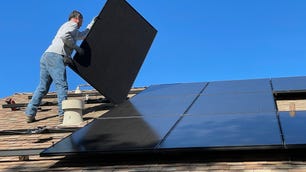Home batteries are a lot bigger and more complicated than the small AA batteries you put in your household gadgets. All those numbers on the specification sheet are confusing, and choosing poorly can mean you buy something too weak to run your appliances — or something more expensive and powerful than you need it to be.
A battery can help you save money by offsetting high time of use rates, using stored energy from your battery to power your home when electricity rates are their highest. You can also use your battery to tap into a supply of stored energy energy from your solar panels after sunset and have backup energy on-hand in case of a blackout.
If you’re shopping for a home battery, consider your battery’s power output.
Can solar panels save you money?
Interested in understanding the impact solar can have on your home? Enter some basic information below, and we’ll instantly provide a free estimate of your energy savings.
“You will want to size a battery based on the load that it is serving,” Dan Cook, the chairman of the Ohio Energy Storage Association, told CNET. “For a home battery paired with solar, it’s important to determine how much power you will still be pulling from the grid based on the size of each component in relation to your home’s energy use.”
What is a home battery power output rating?
Your battery’s power output is essentially the amount of power your battery can handle at a given time.
There are two types of power output ratings: peak and continuous. Peak output represents the maximum amount of power a battery can handle at one time without risking damage. This can be active for a brief window of time when turning on some power-hungry appliances. The continuous rating is how much power the battery can handle at any moment.
A larger home with more high-power appliances means you’ll want a battery with a higher output. Most battery power ratings can be found in specification sheets and the product’s description, measured in kilowatts.
Kilowatts vs. kilowatt-hours
Battery power output ratings are measured in kilowatts (kW), a unit of energy that measures how much power an electronic appliance is consuming. One kilowatt is equal to 1,000 watts. At the residential level, power ratings measured in kilowatts are standard on most battery nameplates and spec sheets, Cook said.
Batteries are also rated in kilowatt-hours (kWh) which sound similar but measure something different. Kilowatt-hours are used to measure your battery’s capacity — how much energy a battery is able to hold in storage (in kWhs).
While kilowatts measure power at a given moment, kilowatt-hours measure the amount of power consumed over a period of time — the amount of power (in kilowatts) that gets consumed in an hour.
Think of your battery’s power output (in kilowatts) as a measurement of how much power your battery can handle at one instant and the capacity (in kilowatt-hours) as how long your battery will be able to back up your home. Cook said the kilowatt-hour rating may be more helpful in determining the duration of your battery’s life.
How long your battery is going to keep your home powered during an outage will depend on which electrical loads and circuits you’re prioritizing. Powering your air conditioner, EV charger and other energy-hungry loads during an outage will quickly drain your battery. You’ll get more from your battery’s charge by choosing a few essentials to keep powered, like your refrigerator, router, TV and some lights.
Voltage
When looking at battery power, another term you might run into is voltage. This is a unit of electric charge that equates to electrical pressure. Think of voltage as the pressure that pushes energy from your battery to the rest of your home. The higher the voltage means there’s a greater inclination for electricity to move.
Most home batteries operate in 6, 12, 24 or 48 voltage sizes.
“Voltage is important because the battery needs to tie into your load/charging source efficiently and safely,” Cook explained. “Voltage will affect the charging and discharging capabilities of the battery.”
Understanding partial home backup vs. whole home backup
Another thing you’ll want to consider when choosing a battery is how much of your home you want to backup in case there is an emergency power outage. Your battery will either be wired for whole home backup or partial home backup.
A whole home backup system will power the majority of your home during an outage, while a partial home backup system will power a few choice critical loads. In most cases, powering everything in your home when the power goes out is unrealistic and expensive. This would take multiple batteries, and powering all your home’s loads would drain your battery’s charge very quickly. Because of this, most homes with a battery are going to fall under the partial home backup category.
It really comes down to what size battery you install and how much of the home needs to be powered in an emergency scenario. Cook said most household electricity usage fluctuates over a 24-hour period, and your battery may not need to be in backup mode for the whole day.
“Most residential loads go from 5 kW to 15 kW,” Cook said. “In that context, you are not going to need a battery that is bigger than that. You really only need a system that is going to support your residential electricity usage under normal operating conditions.”
How to increase your power output
If you’re concerned about your battery not being powerful enough, there is a way to increase your power output. The way to do this is by adding more batteries. Battery power and capacity are scalable. The more batteries you have, the more power your battery can handle, and the more energy you’ll be able to store.
If you have a 10 kWh battery with an output of 5 kW, then installing another one of those batteries would double your battery’s capacity and output. Combined, you’d have 20 kWh of energy storage capacity and 10 kW of power output.
Determining how much power your battery needs
Your installer is your greatest asset in figuring out how much power you need. They’ll take a look at your household’s energy consumption and help you choose which loads you want to backup. Your installer is likely also going to ask how you plan to use the battery, whether you plan to use it for backup power, time of use offset or both.
You can get an idea of your home’s average monthly power consumption by checking some of your recent electric bills.
“The best way to do it is from your utility bill,” Cook said. “Most utility bills will have some summary data. That will dictate the size of what you need.”
Find a few bills from the winter and summer months. During winter and summer months, you’ll likely be using more power to heat or cool your home. This will show you the more extreme sides of your energy usage.
If your plan is to use your battery for backup purposes, start thinking about which loads in your home you would consider “essential” during an outage. These could be things like your refrigerator, internet equipment, lights, and maybe even heating and cooling appliances. Your installer will most likely install a critical load panel. This panel is separate from your main electric panel and contains the circuits that are deemed essential to power during an outage. The critical load panel helps maximize your stored electricity by making sure power is prioritized to those essential loads.

Knowing your average monthly power consumption is a key element in getting the right battery.
Questions to ask your installer
Your installer should be able to answer any questions you might have, so don’t be afraid to ask.
Cook suggests asking installers about whether the size of the battery is large enough for your home, as well as if the battery can support appliances and power the loads you want.
“Those folks generally have the knowledge to figure it out,” he said.
You should also ask your installer about any battery incentives offered in your area and whether your utility has time of use rates. If it does, what can the battery do to help offset that? You should be clear on why you want the battery and what it will do for you. Shop around for multiple quotes from several installers before settling on a purchase.
Cook cautions against speaking with any door-to-door residential solar salespeople. They might not be completely forthright about the system and what exactly you’re being sold.
Other battery specifications to consider
Beyond power output, there are a few other battery specifications to consider before moving ahead with the purchase of a battery. Knowing a battery’s capacity, depth of discharge and round-trip efficiency can help you compare batteries and get a better understanding of what it’s capable of. All of this can be found on a battery’s specification sheet.
Battery capacity
Your battery’s capacity is the amount of energy it can store, conveyed in a unit of power over time, often referred to as kilowatt-hours. The larger the kWh capacity, the more energy it can store.
“Capacity matters,” Cook said. “If power is the ability to do work, rated in watts, then we need to think about the work that is being done while washing clothes, heating and cooling air, using computers and appliances, etc.”
There are two different capacity ratings to be aware of: maximum capacity and usable capacity. Maximum capacity is the total amount of energy the battery is able to store, while usable capacity is the amount of energy you’ll actually be able to use and have access to.
Some manufacturers will bar off a small amount of a battery’s maximum capacity to prolong the lifespan of the battery and provide a safety cushion in the event you accidentally drain the battery to zero.
Depth of discharge
Depth of discharge is the amount of energy you can drain (discharge) from the battery relative to its maximum capacity. That number signifies the amount of energy (via a percentage) you can drain from the battery all at once without fearing damage. The closer to 100%, the better. Most manufacturers will reveal the battery’s depth of discharge, but not all of them.
It’s not recommended that you drain your battery completely, even if you can. You should keep your battery’s state of charge as high as possible. If you completely drain your battery to zero, you could risk shortening its lifespan.
Round-trip efficiency
Round-trip efficiency is pretty much exactly how it sounds. It’s the efficiency of your battery. To be more specific, it’s the percentage of electricity that makes in and out of battery storage without getting lost along the way, usually to heat.
The higher the round-trip efficiency, the more energy will be stored and discharged efficiently. Most deep-cycle lithium-ion batteries have a round-trip efficiency rating of 90% or higher.
“Round-trip efficiency is important because regardless of the source that your battery charges from, you will want to minimize losses in between full charging and discharging cycles,” Cook said.
What is the average power output of a home battery?
We found the average power output of most home batteries to be between 5 kW and 9 kW, based on the home batteries we’ve reviewed.But there are outliers, and it’s definitely possible to find batteries with power outputs above 9 kW.
How many batteries does it take to power a house?
The number of batteries required to power a house depends on the size of the battery you choose and the appliances that need to be powered. The larger the capacity of the battery, the fewer batteries you’ll need. You’ll also need to take into account your home’s energy consumption and what you plan to use the battery for.
The best person to help you figure this out is your installer.


